Part of a series of articles titled Intermountain Park Science 2021.
Article
Surveying for Northern Mexican Gartersnakes (Thamnophis eques megalops) at Tuzigoot National Monument
- Tina Greenawalt, Natural Resource Program Manager, Montezuma Castle and Tuzigoot National Monuments, National Park Service
- Iain Emmons, Emeritus Biologist, Northern Arizona University (currently Wildlife Biologist, Vernal Field Office, Green River District, Bureau of Land Management)
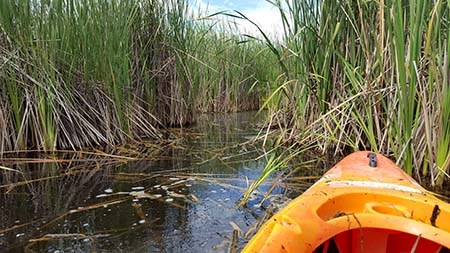
NPS photo.
Introduction
Tavasci Marsh, a 95-acre spring-fed freshwater wetland located within Tuzigoot National Monument, provides unique habitat that contrasts with the typical desert scrub in the rest of Tuzigoot NM and much of the southwestern United States (Figure 1). Once drained to provide more grazing for livestock, the marsh now provides important habitat for many bird species, fish, amphibians, and a population of northern Mexican gartersnakes (Thamnophis eques megalops).
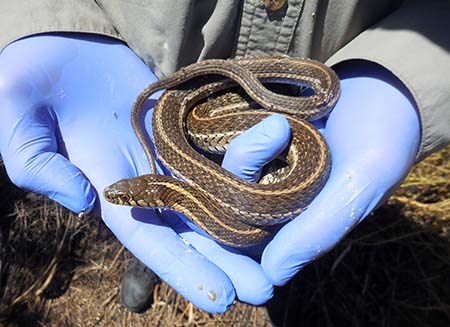
NPS photo.
The northern Mexican gartersnake is a riparian and wetland obligate species native to Arizona, New Mexico, and Mexico (Brennan and Holycross 2006; Emmons and Nowak 2016; Figure 2). Unfortunately, a combination of factors including habitat loss and predation by and competition with non-native species have resulted in population declines. US Fish and Wildlife Service (USFWS) found that reductions in range and population densities have significantly affected the species over the last 30 years. The species was listed as federally threatened under the Endangered Species Act in 2014 (USFWS 2014). The Verde River population of northern Mexican gartersnakes, which includes Tuzigoot NM snakes, is one of less than 10 likely viable populations in the United States (Northern Arizona University, E. Nowak, Assistant Research Professor, personal communication, 26 June 2020). All but one of these recognized populations occur in Arizona.
Our objective for this project was to gain a better understanding of gartersnake population density, demography, and distribution within the marsh. We used both coverboard and trapping surveys in 2016 and 2017. An additional objective for 2017 included capturing five gartersnakes large enough for implantation of radio transmitters that would allow us to track what areas of the marsh were being used by the snakes including where they overwinter.
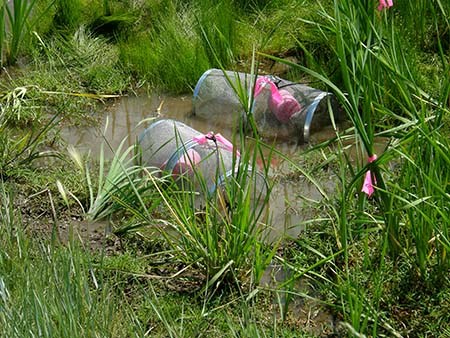
NPS photo/Iain Emmons.
Methods
Since 2011, we have used two methods to survey for northern Mexican gartersnakes with guidance and assistance from Erika Nowak, Assistant Research Professor at Northern Arizona University. In one method, we used coverboards, which consist of 2’x 3’ plywood boards that can be used as cover for the gartersnakes. There are approximately 50 of these plywood coverboards around the perimeter of Tavasci Marsh. During the survey, the coverboard is flipped over in order to see what is underneath. These surveys are less effort-intensive than the second method and are conducted primarily during the spring and fall months, to coincide with increased movement patterns before and after the brumation period (a period of sluggishness in winter).
Trapping surveys (second method) with minnow traps require more effort but have typically resulted in a higher number of gartersnakes captured. These surveys are conducted primarily during the warmer summer months of the active season to coincide with foraging and movements near water features. Trapping surveys had been conducted by NAU in 2012 and then initiated again by park staff with assistance from NAU in 2016. These surveys consist of using metal minnow traps that have a funnel opening at each end (Figure 3). The traps are placed partially submerged in the marsh. Prey species such as tadpoles or fish get caught in the trap, which then attract the gartersnakes. Snakes can also enter traps when the traps are placed strategically in travel corridors and natural funnel areas.
Trapping surveys were conducted in June and September of 2016 and July through September of 2017. In 2016, 90 to 100 1/8 inch GeeTM minnow traps were set out in the marsh. In 2017, 92 traps were set out in July and early August and approximately 50 traps were set out in late August and September. Traps were located in areas where gartersnakes were likely to occur during the warmer summer months including along the edge of the marsh both in and out of the water, in and along channels in the marsh, and in shallow pools of water. Traps were checked twice a day during the duration of the trapping surveys.
Survey hours were calculated by taking a sum of the person hours for conducting the coverboard or trapping surveys each year. Survey hours for checking coverboards will hereafter be identified as “board hours,” while survey hours for checking traps will be identified as “trap hours.”
During the morning trap checks, all captured vertebrates were counted and identified to species. This method allowed us to determine relative abundance of the snakes, potential prey, and predator species (Emmons and Nowak 2016). We recorded the length of vertebrates in 5 different size classes (<1 inch, 1-2 inches, 2-3 inches, 3-4 inches, and 4-5 inches). Additional measurements were taken for amphibians including weight and snout to vent length. They were also categorized by age class according to previous studies done in Arizona (Sullivan 1983; Emmons et al. 2016). Age class categories were adult (> 135 mm), subadult (<135 mm and >80 mm), juvenile (<80 mm), and tadpole for American bullfrog (Lithobates catesbeianus) and adult (>60 mm), juvenile (<60 mm), and tadpole for Woodhouse’s toad (Anaxyrus woodhousii). Crayfish (Orconectes virilis) were categorized in size classes of less than 3 inches and greater than 3 inches (Emmons and Nowak 2016). Afternoon trap checks involved simply checking the traps for gartersnake presence.
All captured gartersnakes were measured, weighed, sexed, and marked with unique microbrand combinations on the scales on the underside of the snake’s tail using a medical cautery (Winne et al. 2006). Larger snakes also had a small passive integrated transponder (PIT) tag implanted as a secondary method of identification (Emmons and Nowak 2016). PIT tags, also called microchips, are commonly used as identification for family dogs. Every time a snake was captured it was checked for microbrand markings and a PIT tag.
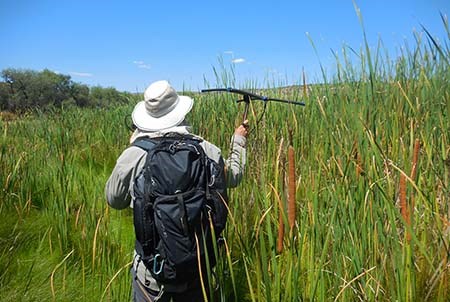
NPS photo.
Only one snake out of the thirty-two individuals captured in 2017 was large enough to have a radio transmitter implanted. The snake was an adult female captured opportunistically on July 26th about 190 meters away from the closest trap. A 0.17 ounce (5 g) SB-2 transmitter unit with a temperature sensor (Holohil Systems Ltd.) was implanted surgically by a veterinarian at Alpine Animal Hospital in Flagstaff, Arizona. Following surgery, the snake was kept at the NAU Animal Care Facility to recover for six days. The snake was then transported back to Tuzigoot and released back in Tavasci Marsh on August 8th.
The snake was located two to three times a week using a VHF telemetry receiver and antenna (Telonics, Inc.) (Figure 4). Each time the snake was located, data was recorded for the location using a Trimble GeoXT GPS unit. Other data collected included behavior of the snake (if seen), habitat type, type and percentage of ground cover, stream morphology, distance to water, waterflow type, water depth, slope severity, temperature of air and water, and wind speed.
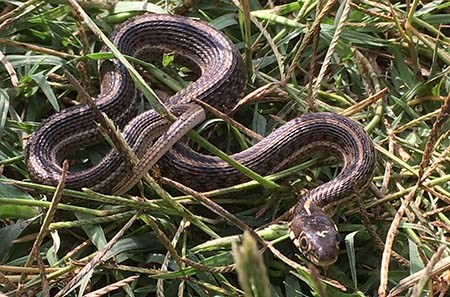
NPS photo/Iain Emmons.
Results
In 2016, one northern Mexican gartersnake was found under coverboards during 134.3 board hours. In comparison, seven snakes were captured in traps with two additional snakes captured opportunistically by hand during 141.8 trap hours; these nine snakes resulted in a detection rate of 0.0005 snakes captured per hour that traps were open during trapping surveys. No previously marked snakes were recaptured in 2016. None of the snakes captured during the 2016 trap surveys were large enough for a PIT tag. Of the nine snakes captured, five were female (55.6%), one was male (11.1%), and three were neonates (young snakes; Figure 5) that could not be sexed (33.3%) (Emmons and Nowak 2016).
In 2017, three snakes were found under coverboards in 74.7 survey hours. In comparison, 54 snakes were captured in traps during 333.52 trap hours, including 11 recaptures that were captured more than once, which resulted in a detection rate of 0.0009 snakes captured per hour that traps were open during trapping surveys. None of the snakes captured in 2016 were recaptured in 2017 to our knowledge. Eight of the captured snakes were large enough for PIT tags and one snake had a radio-transmitter implanted. Of the thirty-two snakes captured, fourteen (43.7%) were male, four (12.5%) were female, and fourteen (43.7%) were neonates that could not be sexed. The branding tends to fade as snakes shed their skin and could be difficult to impossible to detect a year later, which is why PIT tagging is preferred.
Eight potential prey species were detected in the traps during the 2016 and again in the 2017 surveys (Table 1). All of these species except Woodhouse’s toad are non-native. In addition to the potential prey species detected, many non-prey species were captured in 2016 including crayfish (Orconectes virilis), spider (Dolomedes sp.), pill bug (Armadillidium vulgare), dragonfly (Anax spp.), damselfly (Suborder Zygoptera), dobsonfly (Corydalus cornutus), snail (Class Gastropoda), crane fly (Tipula paludosa), katydid (Scudderia sp.), cricket (Gryllus sp.), diving beetle (Family Dytiscidae), terrestrial beetle (Family Coreidae), and leech (Family Erpobdellidae) (Emmons and Nowak 2016). These same non-prey species were captured in 2017 along with water scorpion (Ranatra sp.), Asiatic clam (Corbicula fluminea), worms (Family Naididae), and a walking stick (Diapheromera arizonensis). Several of the species caught in the traps were potential predators of the snakes including American bullfrog and crayfish.
|
Species |
Number Detected in 2016 |
Number Detected in 2017 |
|
Mosquitofish (Gambusia affinis) |
1,407 |
20,526 |
|
Green Sunfish (Lepomis cyanellus) |
133 |
237 |
|
Bluegill (Lepomis macrochirus) |
10 |
1 |
|
Smallmouth Bass (Micropterus dolomieu) |
2 |
7 |
|
Largemouth Bass (Micropterus salmoides) |
12 |
15 |
|
Black Bullhead (Ameirus melas) |
6 |
3 |
|
American Bullfrog (Lithobates catesbeianus) |
151 |
977 |
|
Woodhouse’s Toad (Anaxyrus woodhousiiI) |
434 |
38 |
Table 1: Potential prey species captured during the 2016 and 2017 surveys.
We radio-tracked the snake sixteen times between August 8th and September 25th, 2017. During this time, the snake mainly stayed in the south-central portion of Tavasci Marsh in habitat consisting of deeper water and cattails (Typha sp.). Five attempts were made after September 25th to try and locate the snake before we found it deceased on October 12th. The snake was found dead on land on the eastern side of Tavasci Marsh and had evidence of predation due to a large slash in its body. Other than the slash it had no obvious wounds.
Discussion
Trapping surveys with minnow traps continue to be a more effective method than the coverboard method for capturing greater numbers of gartersnakes at Tuzigoot NM. Minnow traps require a more intense effort but detected many more snakes in a comparatively shorter period of time than the coverboard surveys. However, coverboards still have value because they resulted in captures of other individual snakes that we didn’t see in the traps. Coverboards might also assist in capturing larger individuals.
Detection rates for northern Mexican gartersnake in this study (0.0005 in 2016 and 0.0009 in 2017) were within the rates for other projects in the Verde River population which varied from 0.0004 to 0.0017 (Northern Arizona University, E. Nowak, Assistant Research Professor, personal communication, June 26, 2020). The capture rate for another population in Arizona was 0.0001-0.0002. All of these detection rates refer to the number of snakes found per hour that traps were open over the course of a trap survey. Even the highest rate (0.0017) is still a small fraction, meaning that a lot of hours of keeping traps open are required on average to capture a single snake. Another way to look at this is that it took approximately 588 hours of trapping to capture one snake at the site with the highest detection rate (0.0017).
Detection rate for snakes during trapping surveys nearly doubled between 2016 and 2017. This result may be due to timing of surveys, length of surveys, trap location, an increase in snake population, trap locations near recent birth sites for multiple neonate (newborn) gartersnakes, or a combination of these factors. We conducted more trapping surveys in 2017 than 2016. Trapping surveys were conducted in June during 2016 and July and August in 2017. No large adult snakes were caught during the June 2016 surveys. Female northern Mexican gartersnakes typically give birth in June and therefore, may not be as active. July was the most productive month during our trapping surveys. In the first four days of the trapping in July 2017, fifteen individual snakes were captured and two of those individuals were each recaptured once. July could be a more active time due to a variety of factors including prey availability, more active neonates that were born in June, or weather patterns including the start of monsoon season.
Snakes were also recaptured during trapping for the first time in Tavasci Marsh in 2017. This is likely due to the length of the trapping surveys. Instead of conducting a weeklong survey, we continuously surveyed for four weeks. For future survey efforts, it would probably be more beneficial to conduct longer trapping surveys (at least two weeks) both in terms of numbers of individuals captured and recaptures. This species is elusive, secretive, and requires considerable survey effort to detect an individual. Given this situation, trapping surveys that are conducted for multiple weeks will increase the likelihood of individuals being captured and recaptured. In fact, the four week trapping survey done the in 2017 represents one of the most time-intensive efforts (in terms of continuous duration of time) for this species, and the number of captures/recaptures is relatively large within a survey trip, compared to other survey efforts for this species. In 2017, five individuals were recaptured one time each, another five individuals were recaptured twice, one individual was recaptured three times, and one individual was recaptured four times. Recaptured snakes can provide valuable information for the species to inform land managers, including growth rates within and between years, movements based on capture locations in successive survey trips within a year and between multiple years, and estimation of population size.
We fell short of our goal for implanting radio transmitters in five snakes since only one of the 32 snakes captured was large enough. In addition, since the snake with a radio transmitter was predated prior to entering its overwintering site, the habitat use data we collected was limited to a short duration of the active season. However, prior to predation this individual did exhibit similar spatial behavior and habitat use to the one other snake previously tracked at Tavasci Marsh from 2012-2013. The snake was an adult female similar in size and they both spent the majority of time in central portions of the marsh that featured deeper water along the edges of dense cattails (Emmons 2017). It is possible that additional larger snakes are more frequently associated with habitat and prey conditions found in the center of Tavasci Marsh during June-September. Placing traps in these areas would be difficult as shallow water is needed in order to not submerge the traps, and dense cattails in deep water create challenging conditions for survey access. However, trapping and survey efforts in spring and fall when snakes are migrating to and from terrestrial overwintering sites may result in the capture of additional larger snakes; coverboards could be beneficial for this purpose. Tracking the snakes to determine where they overwinter has important management implications for projects that are conducted in winter such as vegetation management, trail maintenance, or construction projects that utilize heavy equipment. Future research goals are to conduct additional trapping to capture individuals large enough for implantation of transmitters and use radio telemetry to collect additional information on spatial ecology and habitat use for northern Mexican gartersnakes at Tavasci Marsh.
References
Brennan, T .C., and A. T. Holycross. 2006.
A field guide to amphibians and reptiles in Arizona. Arizona Game and Fish Department, 150 pp.
Emmons, I. D. 2017.
Ecology of federally threatened Northern Mexican Gartersnakes in north-central Arizona. Thesis. Northern Arizona University, Flagstaff, Arizona.
Emmons, I. D., and E. M. Nowak. 2016.
National Park Service monitoring surveys for northern Mexican gartersnakes (Thamnophis eques megalops) at Tuzigoot National Monument, Arizona. National Park Service Unpublished Report, Flagstaff, Arizona.
Emmons, I. D., E. M. Nowak, and K. K. Lauger. 2016.
Prey availability and foraging events of the northern Mexican gartersnake (Thamnophis eques megalops) in north-central Arizona. Herpetological Review 47:555-561.
Sullivan, B. K. 1983.
Sexual selection in Woodhouse's toad (Bufo woodhousei). II. Female choice. Animal Behaviour 31:1011-1017.
US Fish and Wildlife Service (USFWS). 2014.
Endangered and Threatened Wildlife and Plants; Threatened Status for the Northern Mexican Gartersnake and Narrow-Headed Gartersnake; final rule. 50 CFR 17. Federal Register 79 (130) July 8, 2014:38678-38746.
Winne, C. T., J. D. Willson, and K. M. Andrews. 2006.
Efficacy of marking snakes with disposable medical cautery units. Herpetological Review 37:52-54.
Last updated: August 6, 2021
